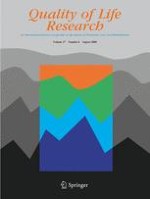01-08-2008
Health state preference scores for children with permanent childhood hearing loss: a comparative analysis of the QWB and HUI3
Gepubliceerd in: Quality of Life Research | Uitgave 6/2008
Log in om toegang te krijgenAbstract
Purpose
The aim of this study was to compare two preference-weighted, caregiver-reported measures of health-related quality of life for children with permanent childhood hearing loss to determine whether cost-effectiveness analysis applied to deaf and hard of hearing populations will provide similar answers based on the choice of instrument.
Methods
Caregivers of 103 children in Arkansas, USA, with documented hearing loss completed the Quality of Well-Being Scale (QWB) and the Health Utilities Index Mark 3 (HUI3) to describe the health status of their children. Audiology and other clinical measures were abstracted from medical records. Mean scores were compared overall and by degree of hearing loss. Linear regression was used to correlate preference scores with a four-frequency pure-tone average, cochlear implant status, and other factors.
Results
Mean preference scores for the QWB and HUI3 were similar (0.601 and 0.619, respectively) although the HUI3 demonstrated a wider range of values (−0.132 to 1.000) compared to the QWB (0.345–0.854) and was more sensitive to mild hearing loss. Both measures correlated with the pure-tone average, were negatively associated with comorbid conditions and positively associated with cochlear implant status. In the best fitting regression models, similar estimates for cochlear implant status and comorbid conditions were obtained from the two measures.
Conclusions
Despite considerable differences in the HUI3 and the QWB scale, we found agreement between the two instruments at the mean, but clinically important differences across a number of measures. The two instruments are likely to yield different estimates of cost-effectiveness ratios, especially for interventions involving mild to moderate hearing loss.
